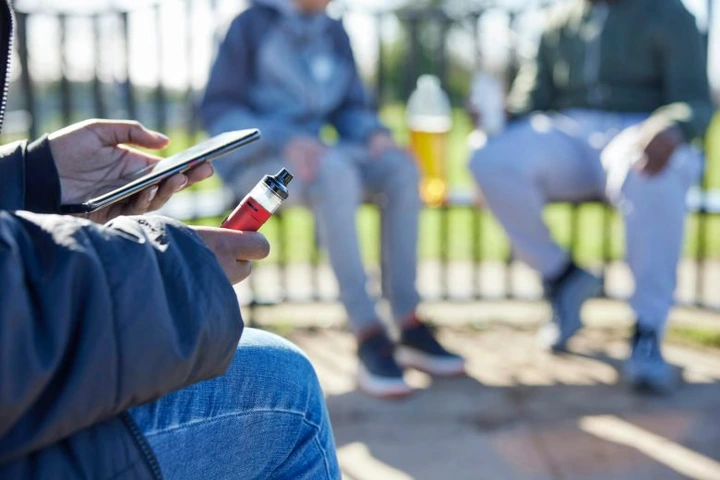
View pictures in App save up to 80% data.
By Jamie Hartmann-Boyce, UMass Amherst; Ailsa R Butler, University of Oxford, and Nicola Lindson, University of Oxford
Lots of people who vape want to quit, but there’s very little guidance on how best to do so.
In the U.S., recent reports estimate that 5.9% of youth and 4.5% of adults currently vape. This proportion varies worldwide, however. In Britain, an estimated 7.8% of youth and 11% of adults vape. Vaping nicotine is addictive, and more and more research is being done to find out how best to quit.
On Jan. 8, 2025, a team of specialists on tobacco use and health policy published a report that draws together the available scientific evidence on how best to support people to quit vaping nicotine. The Conversation asked health policy professor Jamie Hartmann-Boyce from UMass Amherst and tobacco control researchers Ailsa Butler and Nicola Lindson from the University of Oxford – who all authored the report – to explain its key takeaways.
“Cochrane reviews” like this one are often considered the gold standard in evidence. They bring together all the available studies in a certain area and assess their results and how trustworthy they are. They are used by clinicians and policymakers worldwide.
What are the key approaches to stop vaping?
This report emphasizes methods to assist individuals in maintaining a vape-free lifestyle for a minimum of six months.
Our research indicates that interventions delivered via text messaging could assist young individuals in quitting nicotine vaping. These initiatives often offer motivation, support, and actionable tips for cessation, sent straight to users' mobile phones.
All the evidence on these programs came from one text message-based program in particular, called This Is Quitting. People can sign up to this program, which will then send them daily automated, interactive text messages supporting them in quitting.
The duration of the program varies for each person. Up to now, research has only examined this intervention in teenagers and young adults. Additional evidence is required to determine if these programs are effective for older adults, as well as to explore the efficacy of other text-messaging initiatives.
Another promising approach for quitting vaping that we identified through the study is the drug varenicline, marked as Chantix in the U.S. and some other countries. This is a pill that is available only with a prescription and that numerous studies have shown is effective for quitting smoking. Varenicline works by blocking the “rewarding” effects of nicotine. More evidence is needed to understand how effective the drug is for quitting vaping and whether it has any serious side effects when used for this purpose.
Varenicline seemed to enhance the likelihood of successfully quitting by twofold, in contrast to individuals not using any cessation medication. Additionally, the text-message intervention appeared to boost the probability of successfully stopping vaping by approximately 30%.
These are the only two strategies with enough evidence to support their effectiveness in helping individuals quit for six months or longer; however, additional research is currently in progress.

View pictures in App save up to 80% data.
What are the potential dangers of vaping?
For people who smoke, evidence shows that switching to nicotine vaping can improve their health and help them stay smoke-free.
However, though less harmful than smoking, nicotine vaping is likely to cause more harm than not vaping or smoking.
People who’ve used vaping to quit smoking are advised to ultimately quit vaping, too. There are also lots of people who vape nicotine who’ve never smoked – for them, vaping nicotine may be harmful.
Many people who want to quit vaping also want to save money and be addiction-free.
Determining the health risks associated with nicotine vaping is complex and cannot be generalized. The dangers of vaping fluctuate significantly based on the type of device used and the specific ingredients found in the vape liquid.
People who vape should make sure they are using products that have been regulated and tested – in the U.S., for example, the Food and Drug Administration has authorized marketing of some nicotine vaping products as appropriate for the protection of public health.
Vaping liquids with substances other than nicotine, such as cannabis or opioids, comes with very different risks than vaping nicotine.

View pictures in App save up to 80% data.
Does the report provide any specific recommendations?
It’s hard to make firm recommendations on how to quit vaping nicotine because researchers like us don’t yet have enough evidence. The evidence researchers do have is most promising for the text-message program, specifically when used by younger people, and for the drug varenicline, which people can get a prescription for from their health care providers.
There is some evidence that the drug cytisine might help, too, but it’s not yet available in the U.S. Like varenicline, cytisine works by blocking the rewarding effects of nicotine.
With smoking, people often have to try to quit many times before succeeding. Therefore, if you want to quit vaping nicotine, and have tried before but it hasn’t worked, don’t be discouraged.
We researchers know that people are most likely to succeed in quitting smoking if they use a combination of medications and behavioral support – for example, from a health care provider or a stop-smoking adviser. The same may be the case for quitting vaping. If you want to quit, reaching out to your health care provider or a stop-smoking or stop-vaping service is likely to be a good place to start.
Quitting strategies for vaping and smoking can differ significantly due to the nature of the substances and the habits associated with each. For smokers, traditional methods such as nicotine replacement therapies (like patches, gums, or lozenges), prescription medications, and behavioral therapies are commonly used. These approaches focus on managing nicotine withdrawal symptoms and addressing the physical addiction to tobacco. In contrast, individuals who vape may face different challenges, as vaping devices often deliver varying levels of nicotine and can also contain other chemicals. Quitting strategies for vapers might include gradually reducing nicotine levels in their e-liquids, using apps or support groups tailored specifically for vaping cessation, and finding alternative coping mechanisms to replace the act of vaping. Additionally, the social aspect of both habits can influence quitting strategies. Smokers may need to navigate social situations where smoking is prevalent, while vapers might find it challenging to break the habit due to the variety of flavors and the perception of vaping as a less harmful alternative. Ultimately, the choice of quitting strategies will depend on individual preferences, the level of addiction, and the support available to them.
Many of the methods that have been evaluated to assist individuals in stopping vaping are similar to those proven effective for helping people quit smoking.
There isn’t yet enough evidence to say for sure whether the interventions that help people stop smoking work for vaping, and whether they have any potential harms. It could be that vaping-specific interventions, like changing the characteristics of your e-cigarette – such as by reducing the amount of nicotine in it – could help people quit vaping. But more research is needed.
Individuals who began vaping as a means to quit smoking should ensure that stopping vaping doesn’t lead them back to their old smoking habits.
Smoking cigarettes is more harmful than vaping regulated, nicotine-containing vapes, because the diseases caused by smoking are caused by the burning of tobacco. Vaping does not involve burning anything. Therefore, cigarettes should never be used to help people stop vaping.
There are stories of people doing this, but no one has ever tested this in a study because it would be immoral to do so. Cigarettes kill 1 in 2 users who don’t quit and harm others nearby through secondhand smoke. Their harms far outweigh any perceived benefits.
The Centers for Disease Control and Prevention offers a free helpline for those looking to quit tobacco use – as part of this, they provide stop-vaping support.
This article is republished from The Conversation, a nonprofit, independent news organization bringing you facts and trustworthy analysis to help you make sense of our complex world. It was written by: Jamie Hartmann-Boyce, UMass Amherst; Ailsa R Butler, University of Oxford, and Nicola Lindson, University of Oxford
Jamie Hartmann-Boyce is funded for research by Cancer Research UK (which backed the work discussed in this report), as well as the US National Institutes of Health through the National Institute on Drug Abuse, the National Cancer Institute, and the Center for Tobacco Products of the Food and Drug Administration. Additionally, she receives support from the Truth Initiative, although this is unrelated to the research presented in this study.
Ailsa R Butler is supported by funding from Cancer Research UK via the University of Oxford, which facilitated the research presented in this report.
Nicola Lindson is funded by Cancer Research UK, via the University of Oxford, to conduct research focused on cessation of vaping.
Feature Image: Research into how to quit vaping is still in its infancy. Massimiliano Finzi/Moment via Getty Images










